April 2025
The global automotive 3d map system market is projected to reach USD 16.64 billion by 2034, growing from USD 7.64 billion in 2025, at a CAGR of 9.90% during the forecast period from 2025 to 2034.
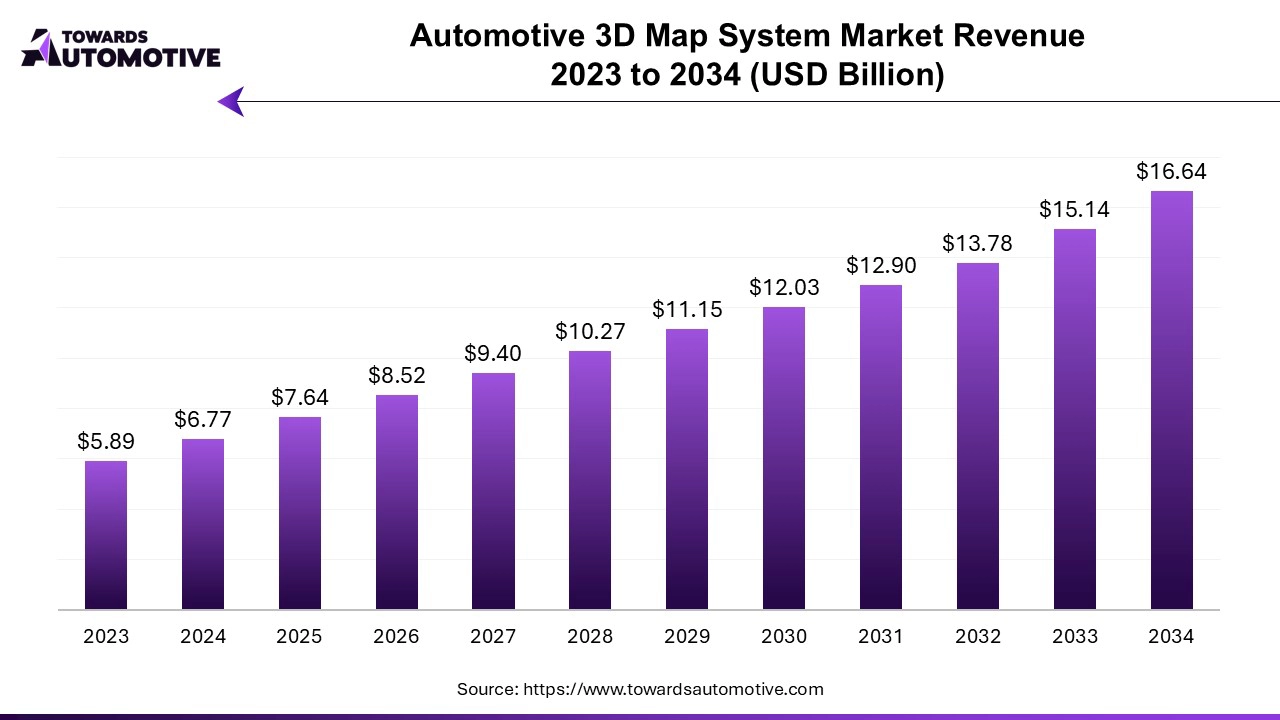
Unlock Infinite Advantages: Subscribe to Annual Membership
The Automotive 3D Map System Market is experiencing significant growth as advanced navigation technologies become integral to modern vehicles. A 3D map system offers enhanced real-time data, providing detailed information about the vehicle’s surroundings, road infrastructure, and potential obstacles. This technology is crucial for autonomous driving and advanced driver assistance systems (ADAS), enabling vehicles to make informed decisions by interpreting complex road environments. The rise in demand for connected vehicles, along with the growing adoption of electric and autonomous vehicles, is driving the need for more sophisticated navigation systems like 3D mapping.
Automotive manufacturers and tech companies are collaborating to integrate 3D map systems with other in-car technologies, such as sensors, cameras, and AI-driven software, to improve safety, navigation accuracy, and overall driving experience. The development of high-definition 3D maps also supports features like real-time traffic updates, lane assistance, and predictive route planning. With increasing urbanization and the need for efficient traffic management, 3D map systems are becoming a cornerstone in smart transportation solutions. As a result, the automotive 3D map system market is poised for rapid expansion, driven by the demand for more advanced, connected, and autonomous driving experiences globally.
AI plays a pivotal role in the Automotive 3D Map System Market by enhancing the accuracy, functionality, and real-time adaptability of mapping technologies. One of the key contributions of AI is in the continuous processing and updating of 3D maps. AI algorithms analyze massive amounts of data collected from various sources like sensors, cameras, GPS, and LiDAR systems installed in vehicles. This data is used to create high-definition maps with precise details about road conditions, traffic patterns, and even environmental factors such as weather.
In the context of autonomous driving, AI is crucial for interpreting these 3D maps in real time. It helps vehicles understand their surroundings by recognizing objects, detecting changes in the environment, and predicting potential obstacles or hazards. AI-powered 3D maps can also provide real-time lane guidance, optimize route planning, and suggest alternate routes to avoid traffic, ensuring a smoother and safer driving experience.
Furthermore, AI enables the integration of 3D maps with other systems such as Advanced Driver Assistance Systems (ADAS), making them more responsive and predictive. By continuously learning and improving from data, AI enhances the overall performance of automotive 3D map systems, making them smarter, more adaptive, and crucial for the future of autonomous and connected vehicles.
The rising sales of commercial vehicles are a significant driver of growth in the Automotive 3D Map System Market. As commercial vehicles, including trucks, vans, and delivery fleets, become more integral to logistics, transportation, and e-commerce, there is a growing need for advanced navigation and mapping solutions. Automotive 3D map systems provide these vehicles with real-time, high-definition maps that improve route efficiency, fuel economy, and overall safety, which are essential for businesses aiming to optimize fleet management.
Increased demand for timely deliveries and efficient transportation, especially in industries like retail, logistics, and construction, requires vehicles to operate with minimal downtime and maximum precision. 3D map systems assist in navigating complex urban environments, managing traffic conditions, and planning the most efficient routes, thereby reducing delivery times and operational costs. These systems are also integrated with advanced driver assistance systems (ADAS), providing drivers with additional safety features such as lane departure warnings, collision avoidance, and real-time traffic updates.
As commercial fleets increasingly adopt autonomous and semi-autonomous driving technologies, the role of 3D mapping becomes even more critical. The growing adoption of these vehicles globally is propelling the demand for sophisticated 3D map systems, driving market growth.
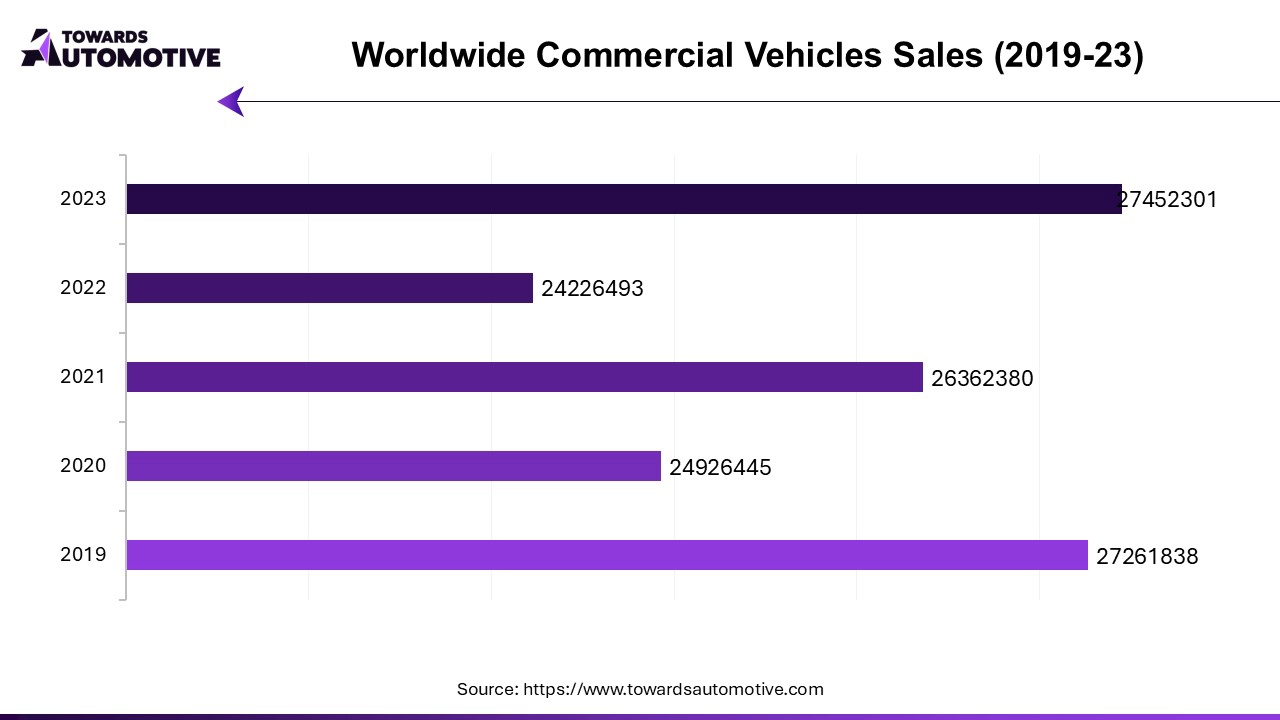
One of the primary restraints of the Automotive 3D Map System Market is the high cost of development and implementation. Creating and maintaining detailed, high-definition maps requires advanced technologies like LiDAR, sensors, and artificial intelligence, which increase production costs. Additionally, integrating these systems into vehicles can raise the overall price of the vehicle, limiting adoption among budget-conscious consumers. Privacy and security concerns also pose challenges, as 3D map systems collect vast amounts of data, raising potential risks around data misuse or cyberattacks. Moreover, the lack of standardized regulations for autonomous driving systems further hinders widespread adoption.
Cloud-based mapping solutions are creating significant opportunities in the Automotive 3D Map System Market by enabling real-time data updates, enhanced navigation, and improved connectivity. Unlike traditional mapping systems that rely on static data, cloud-based solutions continuously update maps with the latest traffic conditions, road changes, and environmental factors. This dynamic nature is particularly valuable for autonomous and connected vehicles, which require precise, real-time information to navigate safely and efficiently.
The ability of cloud-based mapping to facilitate seamless vehicle-to-everything (V2X) communication further enhances its potential. V2X enables vehicles to exchange data with infrastructure, other vehicles, and traffic systems, optimizing traffic flow and improving safety. This technology is crucial for the future of smart cities and autonomous transportation networks, where real-time coordination is key.
Moreover, cloud-based maps reduce the need for large onboard storage, lowering costs and simplifying vehicle designs. These solutions also allow for cross-platform integration, making it easier for automakers and tech companies to collaborate and offer advanced mapping features across different vehicle models. The scalability, flexibility, and efficiency provided by cloud-based mapping are driving their adoption, opening new opportunities for innovation and growth in the automotive 3D map system market.
The software segment held the largest share of the market. The software segment plays a pivotal role in driving the growth of the Automotive 3D Map System Market by providing the technological backbone for advanced navigation, real-time updates, and data processing. As the demand for autonomous and connected vehicles rises, the importance of sophisticated mapping software has grown, enabling the creation of high-definition (HD) 3D maps crucial for safe and efficient vehicle navigation. These software systems incorporate artificial intelligence (AI), machine learning, and big data analytics to offer precise, real-time road and traffic information.
Software advancements have significantly improved the functionality of 3D map systems, offering features such as predictive routing, real-time traffic updates, and enhanced driver assistance. The integration of AI into these systems allows for continuous learning, improving the map's accuracy over time by analyzing data from vehicle sensors, cameras, and LiDAR. This continuous feedback loop is vital for autonomous driving, where minute road details, like lane markings and road curvature, must be constantly updated.
Moreover, software innovation has led to the development of cloud-based solutions, allowing for seamless real-time updates without requiring extensive onboard storage. This reduces costs and offers flexibility, as vehicles can access and update maps remotely. With the automotive industry moving toward smart mobility and connected infrastructure, the software segment is expected to continue driving the growth of the Automotive 3D Map System Market by providing enhanced features, better accuracy, and more efficient data management, aligning with the demands of modern vehicle technologies.
The OEMs segment led the industry. The OEM (Original Equipment Manufacturers) segment is a significant driver of the growth in the Automotive 3D Map System Market, as automakers increasingly integrate advanced mapping technologies into their vehicles to enhance navigation, safety, and driving assistance. OEMs are responsible for designing and producing vehicles equipped with cutting-edge technology, including high-definition (HD) 3D map systems that are essential for features like autonomous driving, advanced driver assistance systems (ADAS), and real-time traffic management.
With the rise of autonomous and connected vehicles, OEMs are under pressure to provide more sophisticated in-car mapping systems that can support navigation in complex urban environments. These 3D map systems allow vehicles to accurately detect road conditions, obstacles, and traffic flow, contributing to smoother and safer driving experiences. Many OEMs are partnering with technology companies to integrate AI-powered map solutions, which continuously update data through cloud services, ensuring real-time accuracy and responsiveness to changes in road conditions.
Furthermore, OEMs are focusing on enhancing the user experience by integrating 3D map systems with infotainment platforms, offering seamless connectivity and smart navigation features. This not only increases consumer demand for advanced navigation capabilities but also boosts vehicle marketability, especially for premium and electric vehicle (EV) segments. By embedding these technologies as standard features in new vehicle models, OEMs are significantly driving the adoption of 3D map systems across the automotive industry, contributing to market growth.
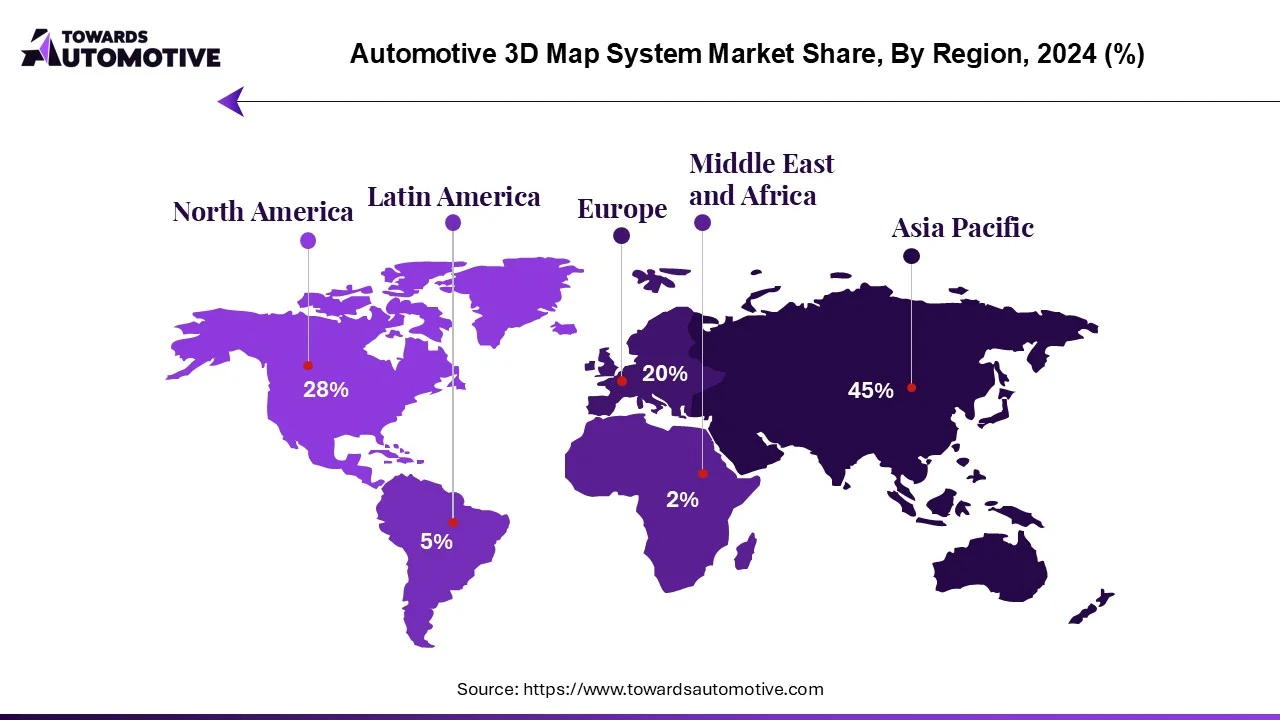
North America dominated the automotive 3D map system market. The growth of the automotive 3D map system market in North America is significantly propelled by the rise of connected vehicles, increasing consumer demand for navigation and Advanced Driver Assistance Systems (ADAS), and the strong presence of technology and automotive companies. Connected vehicles are becoming increasingly prevalent in the automotive landscape, integrating various technologies to enhance safety, performance, and user experience. These vehicles rely on high-definition 3D maps for real-time navigation, enabling features like lane-level positioning, route optimization, and hazard detection. As the number of connected vehicles continues to grow, so does the demand for accurate and up-to-date 3D mapping solutions that can facilitate these advanced functionalities.
Consumer demand for navigation systems is also a critical driver. With an increasing number of drivers seeking efficient navigation options that enhance travel experiences, automotive manufacturers are prioritizing the incorporation of advanced mapping systems in their vehicles. The need for real-time traffic updates, dynamic rquality 3D maps, allowing consumers to make informed travel decisions.
Moreover, the strong presence of technology and automotiveerouting, and precise mapping is pushing the demand for high- companies in North America plays a pivotal role in advancing the automotive 3D map system market. Major automakers are collaborating with tech firms to develop cutting-edge mapping solutions, enhancing vehicle navigation and safety systems. This collaboration leads to the integration of sophisticated technologies such as AI and machine learning, which improve the efficiency and accuracy of mapping systems. The combined expertise of automotive and tech companies fosters innovation in the 3D mapping space, further propelling market growth. As these trends continue, the automotive 3D map system market in North America is poised for significant expansion, meeting the evolving demands of connected vehicles and tech-savvy consumers.
Asia Pacific is expected to grow with a significant CAGR during the forecast period. The growth of the automotive 3D map system market in the Asia-Pacific (APAC) region is significantly driven by the rise of autonomous and electric vehicles (EVs), government initiatives focused on smart city projects, and continuous technological advancements. The rise of autonomous and electric vehicles in APAC, particularly in leading markets like China, Japan, and South Korea, has created a heightened demand for highly accurate and real-time 3D mapping systems.
Autonomous vehicles (AVs) rely heavily on these systems for safe navigation and obstacle detection, making them an essential component of the broader AV ecosystem. Additionally, as electric vehicles become more prominent in the region, the need for advanced mapping systems that can provide real-time updates on charging stations, traffic, and routes further fuels market demand.
Government initiatives and smart city projects are also crucial drivers of growth in this market. APAC governments are heavily investing in smart city infrastructure, with projects aimed at integrating intelligent transportation systems to manage traffic and reduce congestion. These systems require advanced 3D mapping for accurate traffic monitoring, real-time navigation, and safety enhancements, creating substantial demand for automotive 3D maps. Countries like China and Japan are leading in the adoption of smart city technologies, accelerating the integration of such systems into urban transportation.
Technological advancements and collaborations between automakers, technology companies, and software developers are also playing a pivotal role in driving the market. As 5G networks and AI technologies become more advanced, they enable the development of more precise, dynamic, and interactive 3D mapping systems. Collaborations between automotive companies and tech giants help enhance the capabilities of these mapping systems, making them more efficient for real-time data processing, improving navigation accuracy, and enabling seamless integration with autonomous driving technologies. This continued innovation positions APAC as a major growth hub for the automotive 3D map system market.
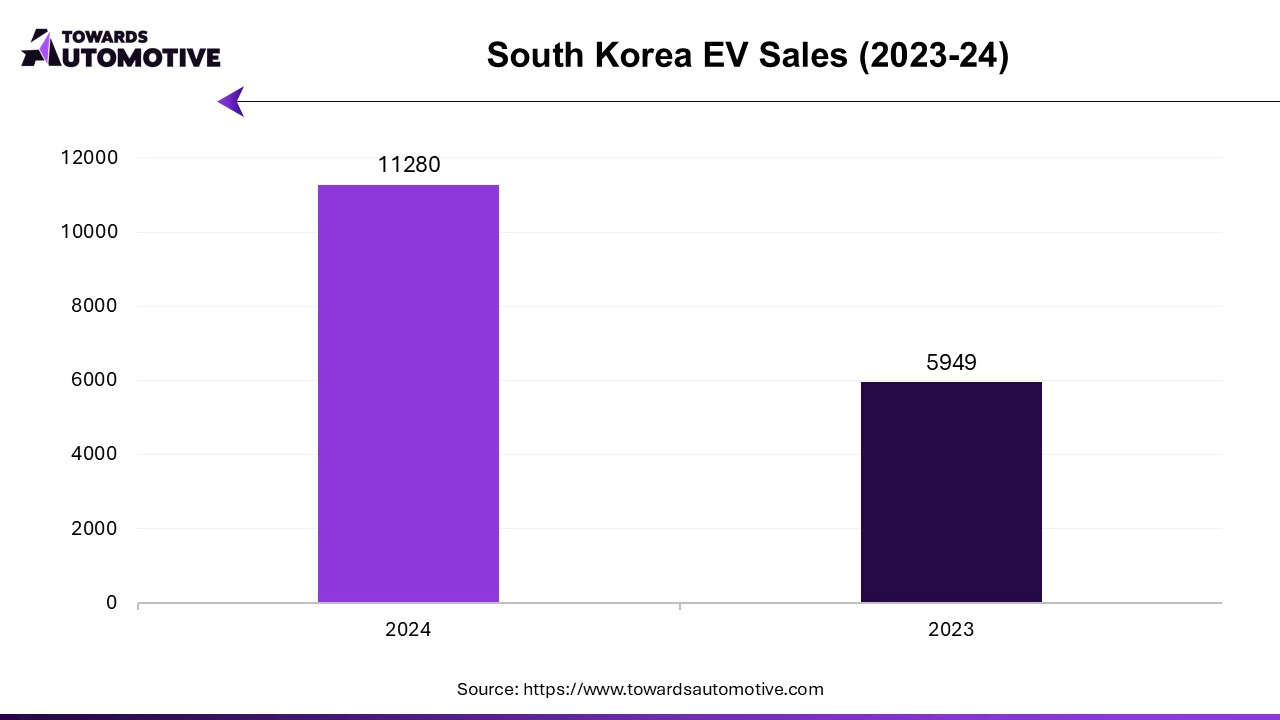
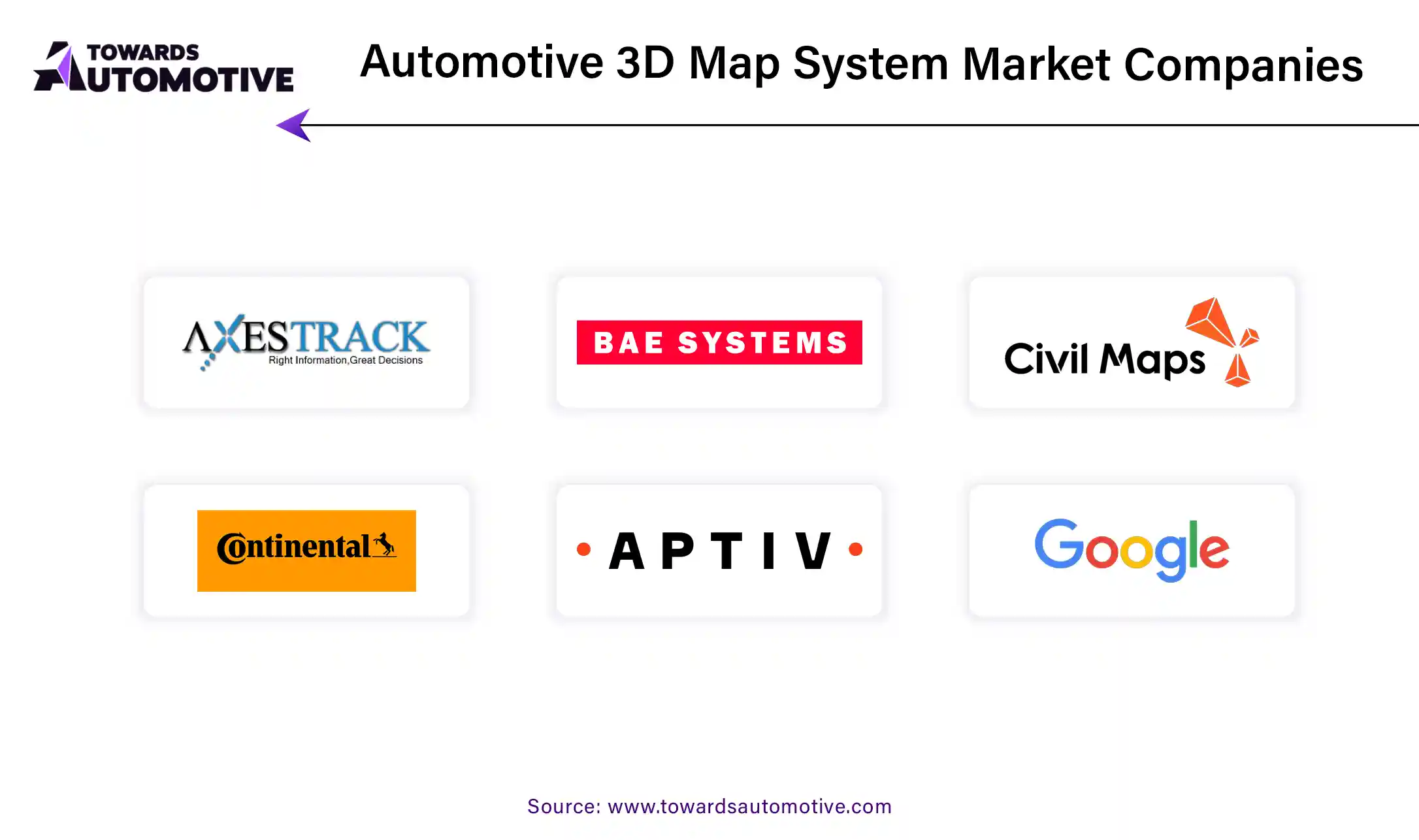
By Navigation
By System
By Vehicle Type
By Sales Channel
By Region
April 2025
April 2025
April 2025
April 2025
We offer automotive expertise for market projections and customizable research, adaptable to diverse strategic approaches.
Contact Us